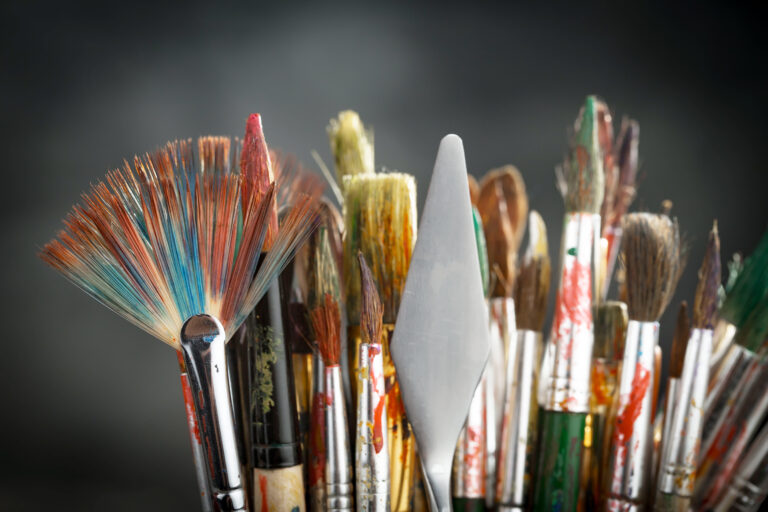Paintbrushes date back to the Paleolithic era around 2.5 million years. Ancient Chinese and Egyptian civilizations were among the first to develop painting with brushes for fine art and decoration.
In terms of design, very little has changed since then. Brushes were made from animal hair, and their material and shape have stayed virtually the same. There is, however, a wider range of modern brushes to suit the ever-growing choices of mediums and surfaces we paint on.
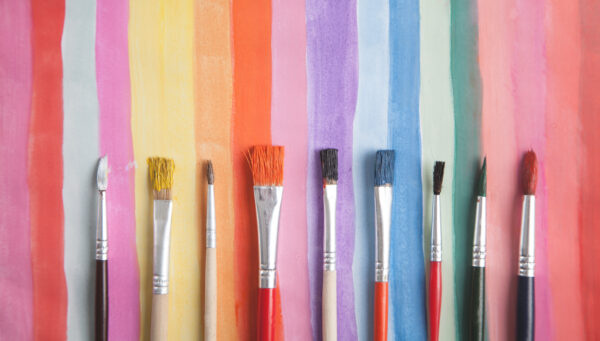
Brush shapes
Other than size, there are six different shapes of brushes: flat, round, brights, filberts, fan blenders and riggers. You might not use all types, but the first two are your all-round brushes.
Flat brushes
These square-ended brushes can be used flat to create long fluid strokes or turned sideways to make fine lines and small details. This will be the workhorse of your brush collection.
Round brushes
These have a tapered edge that can be used for diluted paint and for painting large areas in the earlier stages of the painting. You can use the tips or press harder and make bold thick marks (the belly of the bristles can hold a lot of paint).
Bright brushes
At first look these short, flat brushes look like the classic flat brush, but look closer and the bristles are significantly shorter and far stiffer. They can be easier to control the paint than long flats, but the best thing is that the stiff bristles dig deep into the paint and can help create texture and impasto. Smaller versions are great for textured detail and short strokes.
Filbert brushes
My favorite brush name, the filbert sits in between flat and round bristles. They have curves, and the bristles are generally softer. Use after the top three brushes if you want to soften or blend any edges.
Fan blending brushes
These are available in all materials and are generally used to feature paint. They were also used almost exclusively by TV artist Bob Ross, who dabbled with them to create the texture on his ubiquitous pine trees and mossy river banks. For most artists, they are simply used for soft, thin background shapes.
Riggers
These long thin pointed bristles are used to create thin detailed lines or outlines. The long thin bristle carries a deceptive amount of paint allowing for an uninterrupted line. The name comes from their original use for marine paintings.
Household brushes
For abstract artists, or those creating large single areas of color, household paintbrushes can be really useful. You can usually choose brushes suited to water and oil-based paints. They are available in widths from one inch upwards, and artists will often shave bristles to create bespoke sizes. Using the brushes dry on dry can create white areas of scumble.
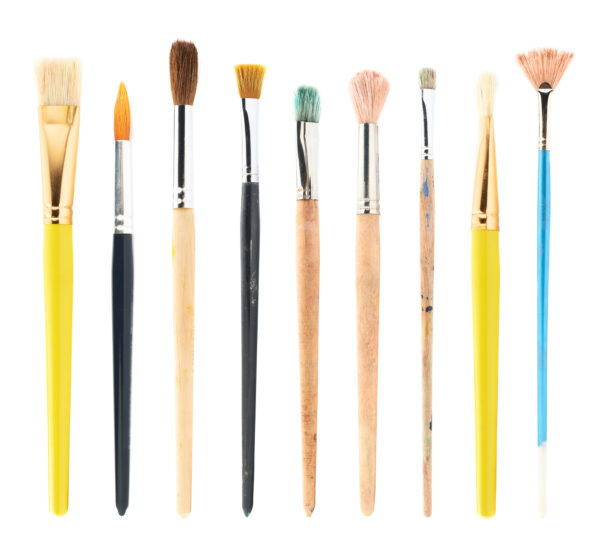
Animal hair brushes
Brushes date back thousands of years and were originally made from animal hair. The harvesting of the hair used for paint brushes can be done through grooming or may be done through trapping. There are now many synthetic options that mimic the textures and strengths of animal bristles, but some artists continue to use the original implement.
- Sable – These expensive brushes are made from the tails of an animal called a sable marten similar to a mink. The bristles can be harvested from cold countries where the hair is tougher. These soft springy brushes are an expensive extra for oil painters. Their softer bristles make them ideal for the final details in oil painting.
- Hog hair – These are made from hog bristles. The more expensive kinds can be handpicked from specific parts of the hog.
- Squirrel – A cheap sable-like brush, these will wear out more quickly, but can be useful for washes.
- Ox – A coarse bristle that comes from the ear of certain breeds of cow. They are better for square brushes and longer bristles as they can be flexible.
- Goat – More commonly used in watercolor painting, the bristle holds a large amount of water making them ideal for washes.
Vegan paint brushes
Our appetite for using animal-based products has decreased dramatically in recent years and the art world is no exception. Synthetic or vegan paintbrushes have been around for a long time, but were originally created as a cheaper alternative to “real” brushes. However, these alternative brushes are now designed to replicate every bristle type (and the prices have increased).
Synthetic brushes are made from a variety of materials, including nylon and polyester. Critics say they fall short of the performance of traditionally made brushes, in particular for fine work and watercolors.
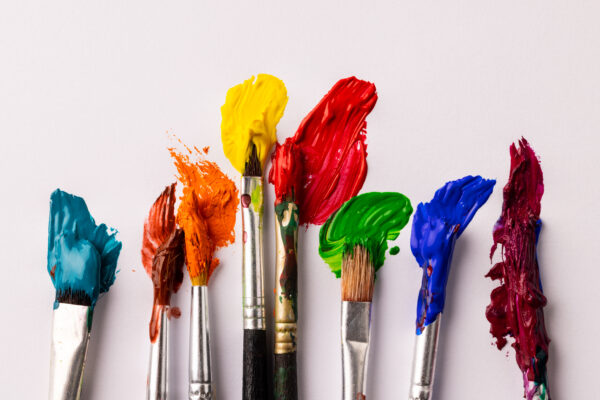
Brush sizes
Brush sizes range from 000 to around 16, but this is only a rough guide. The best way to choose brushes is to hold them against each other and bend the bristles to get an idea of the level of give they have. You will need different sizes, but if you are buying expensive brushes, only buy the sizes you want.
Which brush works with which medium?
Each medium requires a different type of bristle, while there are dozens of different shapes and sizes, your choices will mostly depend on your style and medium of painting.
Best brushes for oil paint
Oils require tougher bristles: These heavy-duty bristles can cope with the thick medium and the rough surface (canvas, board or even metal). They also need to survive constant dunking and scrubbing in turps or similar brush cleaners. In terms of the best shapes for oil paint, it makes sense to use flat and round brushes, the filbert and bright – as well as a selection of well-worn household brushes in different sizes.
Many artists like older brushes, the bristles age over time, become rougher, the bristles wear into unique shapes. Most oil paint brushes are made from hog bristles.
Best brushes for watercolors
Brushes for watercolors are softer, often made from sable (or squirrel), and you will find that the round brushes and rigger brushes are the most commonly used. There’s also a shorter version of the rigger, nicknamed a spotter brush that allows a lot of control for detailed work. Flat brushes and so-called mop brushes are used for large expanses of color and background.
Best brushes for acrylic paint
There are many wonders of using acrylic paint. The water-based medium can be used on a wide variety of surfaces. And it is also suitable for a wide range brush types. However, you should avoid using the same brushes for different mediums. It can make them difficult to keep clean and risks mixing water and oil-based paints.
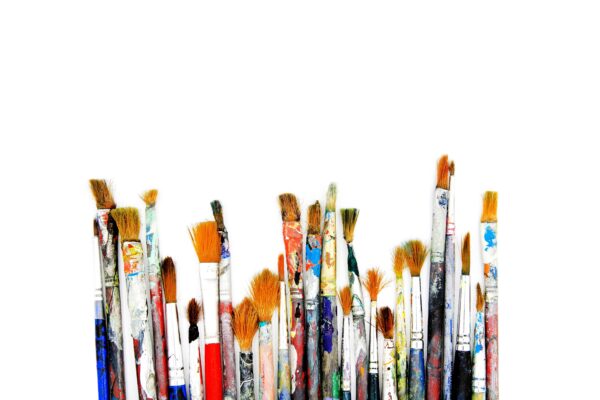
Looking after your brushes
If you don’t look after your brushes, they won’t look after you, and you will quickly find yourself back in the art supply shop buying more. Brushes should always be cleaned and dried as soon as possible after use. Brushes should be stored bristle up to dry. This prevents the bristles from bending, but also makes it easy to pick the right one.
Acrylic paint dries quickly, so brushes will need to be cleaned straight after use. Removing dried paint from a brush means using methylated spirit (or more often, they end up in the bin).
One final note: Never throw an old paintbrush away. If you can’t clean them sufficiently to reuse them for their original purpose or the bristles are damaged, keep them for mixing paints and creating novel textures.

